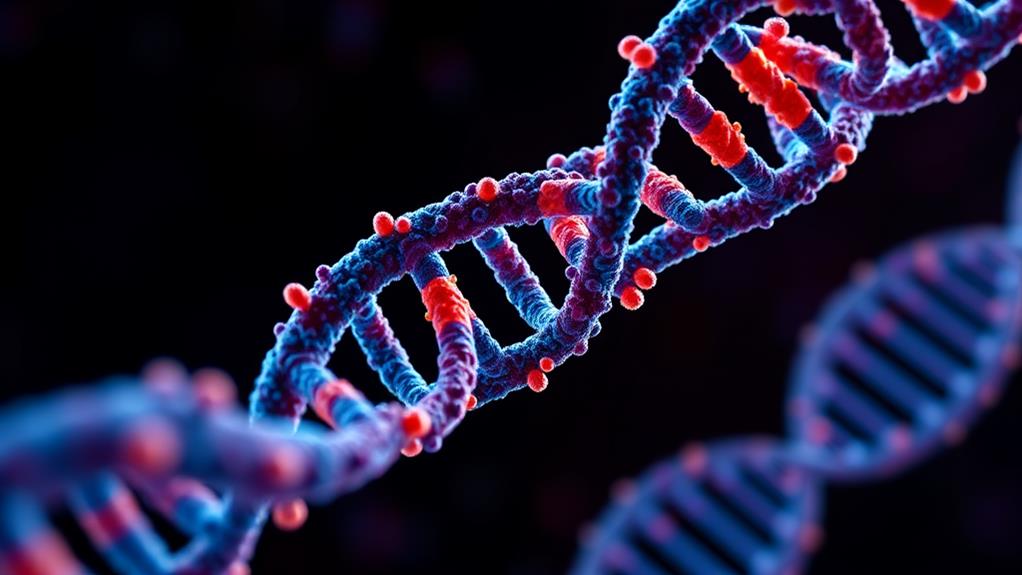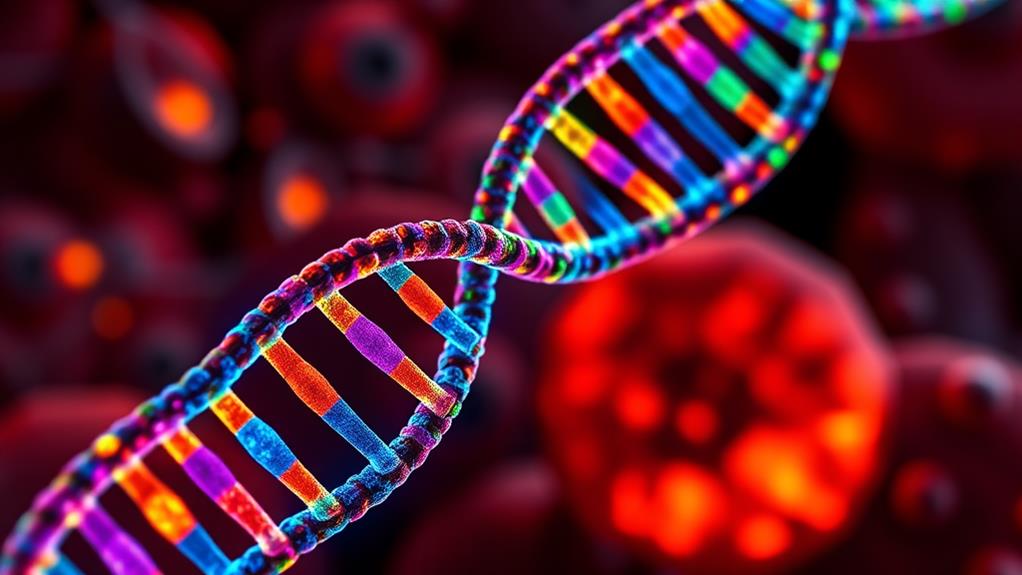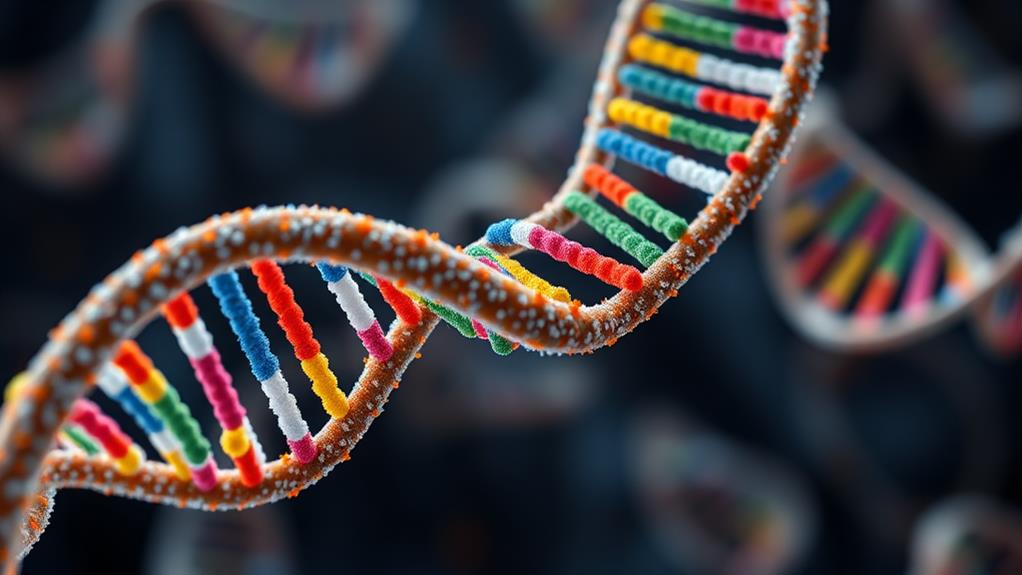DNA replication errors are corrected through multiple mechanisms to guarantee genetic stability. You'll find that DNA polymerase proofreading is the first line of defense, catching about 99% of mistakes during replication. Mismatch repair systems then address errors that slip through, fixing mismatched base pairs. For more severe damage, nucleotide excision repair removes and replaces larger segments of DNA. Base excision repair tackles smaller, non-helix-distorting lesions. Additional processes like strand slippage correction and wobble effect mitigation further enhance accuracy. These systems work together to maintain DNA integrity, preventing mutations that could lead to diseases. Understanding these mechanisms provides insight into the complexity of genetic maintenance.
DNA Polymerase Proofreading
Precision is the hallmark of DNA polymerase proofreading. This remarkable process plays an essential role in maintaining genetic stability during DNA replication. You might wonder how DNA polymerases achieve such accuracy. The answer lies in their built-in proofreading mechanism.
As DNA polymerases synthesize new DNA strands, they're equipped with a special 3' to 5' exonuclease activity. This allows them to detect and correct replication errors almost immediately after they occur. When an incorrect base is added, the enzyme stops, backs up, and removes the mistake. It then replaces it with the correct nucleotide before continuing.
This proofreading ability is incredibly effective, correcting about 99% of replication errors. As a result, the overall error rate is reduced to approximately 1 in 1 billion nucleotides. That's an astonishing level of accuracy!
You can think of DNA polymerases as vigilant editors, constantly checking their work. This process is essential because uncorrected errors can lead to mutations, which may contribute to diseases like cancer.
Mismatch Repair Systems
Catching what slips through the cracks, mismatch repair systems serve as an essential second line of defense against DNA replication errors. These systems correct approximately 1 in 1,000 mismatches that escape the proofreading activity of DNA polymerases.
You'll find that this process involves several key proteins that recognize and bind to mismatched base pairs, removing the incorrect nucleotide and replacing it with the correct one using the complementary strand as a template.
In E. coli, you'll notice that the mismatch repair system uses adenine methylation to distinguish between parental and newly synthesized strands, ensuring the right strand is repaired.
It's important to understand that failures in this system can lead to an increased mutation rate, contributing to various cancers, particularly hereditary nonpolyposis colorectal cancer.
The efficiency of mismatch repair systems markedly reduces the overall mutation rate during DNA replication. This maintenance of genomic stability results in an impressive error rate of about 1 in 10 billion nucleotides replicated.
Without these systems, you'd see a much higher frequency of mutations, potentially leading to severe consequences for cellular function and organism health.
Nucleotide Excision Repair
Nucleotide excision repair (NER) is an essential mechanism for correcting DNA damage caused by bulky lesions.
You'll find that this process begins with specialized proteins recognizing distortions in the DNA helix and recruiting repair factors to the site.
Once identified, a complex of enzymes excises a short DNA segment containing the damage, which is then filled in by DNA polymerase using the undamaged strand as a template.
Identifying DNA Lesions
The sentinel proteins of our genetic code are always on high alert. These DNA repair enzymes play an essential role in identifying and addressing DNA damage that can compromise genomic stability.
When it comes to nucleotide excision repair (NER), specialized proteins are tasked with detecting distortions in the DNA helix. You'll find that these proteins are particularly adept at recognizing lesions like thymine dimers, which are often caused by UV light exposure.
Once a distortion is identified, the NER machinery springs into action. It's a complex process that involves multiple steps, but it's vital for maintaining the integrity of your genetic material.
The identification of DNA lesions is just the first step in the repair process. After detection, the NER system proceeds to excise the damaged segment, including a short stretch of surrounding nucleotides. This precision guarantees that the damaged DNA is completely removed.
It's a remarkable feat of molecular recognition that helps prevent the accumulation of mutations that could otherwise lead to serious conditions like xeroderma pigmentosa, which increases your risk of skin cancer.
Excising Damaged Segments
Once the DNA repair enzymes have identified a lesion, they're ready to perform cellular surgery. This process, known as nucleotide excision repair (NER), is essential for maintaining genomic integrity. NER targets bulky lesions, like thymine dimers caused by UV radiation, and removes them through a precise mechanism.
Here's how the excision repair process works:
- Recognition of DNA distortions
- Excision of a short single-stranded segment (24-32 nucleotides in humans)
- Synthesis of new DNA using the undamaged strand as a template
- Sealing of remaining nicks in the sugar-phosphate backbone
During this process, multiple proteins work together to recognize and process the damaged DNA. These include XPC, XPB, and XPD, showcasing the complexity of this repair mechanism.
The excision of damaged segments is a significant step in DNA repair, as it allows the cell to remove harmful lesions and replace them with correct nucleotides. This helps prevent mutations and maintains the accuracy of genetic information.
Deficiencies in NER can lead to disorders like xeroderma pigmentosa, which increases skin cancer risk due to impaired repair of UV-induced damage.
Filling DNA Gaps
After the damaged DNA segment has been excised, you're left with a gap that needs filling. This vital step in nucleotide excision repair (NER) is essential for maintaining the integrity of your genetic material.
The process of filling these gaps is a key component in correcting DNA replication errors. To address this gap, your cells employ specialized enzymes called DNA polymerases. These enzymes are responsible for synthesizing new DNA to replace the excised segment. They work by reading the undamaged template strand and inserting complementary nucleotides to rebuild the missing section. This synthesis process guarantees that the correct genetic information is restored.
Once the gap is filled with newly synthesized DNA, there's still one more step to complete the repair. DNA ligase, another important enzyme, seals the nicks in the sugar-phosphate backbone, effectively joining the new DNA segment to the existing strands.
This final step restores the continuity of the DNA molecule, completing the repair process. By efficiently filling these gaps, your cells can effectively correct replication errors and maintain the accuracy of your genetic code, helping to prevent potential mutations and genetic disorders.
Base Excision Repair
Base Excision Repair (BER) is a vital DNA repair mechanism you'll want to understand.
It's a multi-step process involving several enzymes that work together to fix small DNA lesions.
You'll find that BER plays an essential role in maintaining your genomic stability and preventing diseases like cancer by correcting these errors before they lead to mutations.
BER Process Overview
The intricacy of DNA repair shines through in Base Excision Repair (BER), a mechanism that targets small, non-helix-distorting base lesions. When DNA replication errors occur, repair enzymes spring into action to prevent mutations. BER is an essential process that corrects these errors, ensuring the integrity of your genetic material.
The BER process unfolds in several steps:
- A DNA glycosylase recognizes and removes the damaged base
- An AP endonuclease cuts the DNA backbone
- DNA polymerase fills in the gap with the correct nucleotide
- DNA ligase seals the nicks in the DNA strand
This orchestrated sequence of events allows your cells to efficiently correct minor DNA damage.
The process begins when a specialized enzyme detects an abnormal base in your DNA. It then removes this base, creating an abasic site. Next, another enzyme cuts the DNA backbone at this site, allowing for the removal of the sugar-phosphate residue.
DNA polymerase then steps in to synthesize the correct nucleotide, filling the gap. Finally, DNA ligase seals any remaining nicks, restoring your DNA to its proper state.
Enzyme Roles in BER
While the BER process may seem straightforward, it's actually a complex dance of specialized enzymes working in concert. These repair enzymes play essential roles in maintaining the integrity of your DNA.
Let's take a closer look at how they function in base excision repair.
DNA glycosylases are the first to step in, recognizing and removing damaged or incorrect nucleotide bases. This action creates an abasic site, which is then targeted by AP endonucleases. These enzymes cleave the DNA backbone at the abasic site, allowing for the removal of the sugar-phosphate residue.
Next, DNA polymerase takes center stage. It's responsible for filling in the gap left by the removed base, using the complementary strand as a template to guarantee accuracy. This step is critical in restoring the correct genetic information.
Ber's Importance in Health
Now that we've explored the enzyme roles in BER, let's consider why this repair mechanism is so important for your health.
Base excision repair (BER) is an essential process that safeguards your DNA from replication errors and damage that could lead to mutations. Every day, each cell in your body faces thousands of DNA base lesions that, if left uncorrected, might result in serious health issues.
BER's significance in maintaining your well-being can't be overstated. Here's why:
- It prevents mutations that could lead to cancer
- It corrects approximately 20,000 to 30,000 DNA base lesions per cell daily
- It helps maintain genomic stability
- It reduces the risk of genetic disorders
The repair enzymes involved in BER work tirelessly to identify and remove damaged bases, ensuring that your genetic information remains intact.
When these enzymes are deficient or malfunctioning, you're at increased risk of developing various cancers and other health problems.
Strand Slippage Correction
During DNA replication, a pesky problem called strand slippage can occur, leading to potentially harmful mutations. This phenomenon happens when the DNA polymerase, responsible for DNA synthesis, temporarily detaches from the template strand. As a result, it may incorrectly realign with the wrong section, especially in regions with repetitive sequences.
You'll find that strand slippage often leads to insertions or deletions in the newly synthesized DNA strand. If left uncorrected, these errors can become permanent mutations, potentially causing genetic diseases or cancer.
Fortunately, your cells have DNA repair mechanisms in place to catch and fix these mistakes. The mismatch repair system is particularly adept at identifying and correcting strand slippage errors. It works by recognizing mismatched base pairs and excising the incorrectly added nucleotides.
Then, it replaces them with the correct ones, ensuring the fidelity of DNA replication. This process is vital for maintaining genetic stability and preventing the propagation of mutations during cell division. By understanding how strand slippage correction works, you can appreciate the intricate systems that safeguard your genetic information.
Wobble Effect Mitigation
In the domain of DNA replication, the wobble effect presents a unique challenge for maintaining genetic accuracy. This phenomenon allows for non-standard base pairing, which can lead to mispaired nucleotides and replication errors.
To mitigate these issues, your cells have developed sophisticated mechanisms to guarantee genomic stability. Your DNA polymerases play a vital role in wobble effect mitigation through their proofreading ability. They can detect and correct mispaired nucleotides before replication is complete.
Additionally, the mismatch repair system acts as a second line of defense, identifying and fixing errors that slip through initial proofreading. These correction mechanisms are particularly important in:
- Regions with tandem repeats
- Areas prone to strand slippage
- Sequences with high GC content
- Locations susceptible to DNA damage
Environmental Damage Response
Environmental assaults on your DNA are an ever-present threat to genomic stability. Your genetic material constantly faces challenges from various sources, including UV radiation, chemicals, and ionizing radiation. These factors can cause different types of mutations, potentially leading to serious health issues if left unchecked.
One common form of environmental damage is the formation of thymine dimers, which occur when UV light causes adjacent thymine bases to bond incorrectly. This distorts the DNA structure and can interfere with normal cellular processes.
Fortunately, your cells have sophisticated DNA repair processes to combat these threats. The nucleotide excision repair (NER) mechanism is essential for identifying and fixing bulky DNA lesions, including thymine dimers. Another important process, base excision repair (BER), handles smaller, non-helix-distorting lesions.
These repair mechanisms work tirelessly to maintain your genomic integrity in the face of environmental challenges. Without them, mutations can lead to permanent changes in your DNA, increasing the risk of diseases such as skin cancer.
Spontaneous Mutation Prevention
While environmental factors pose significant threats to DNA integrity, your cells are also constantly battling against spontaneous mutations. These naturally occurring errors in DNA sequences can arise from normal cellular processes, but your body has developed sophisticated mechanisms to prevent them from becoming permanent.
Understanding these mechanisms is essential, as they play an important role in the benefits of DNA testing for evaluating health risks and optimizing lifestyle choices.
To combat spontaneous mutations, your cells employ several strategies:
- DNA polymerases with proofreading capabilities
- Mismatch repair mechanisms
- Continuous DNA repair processes
- Specialized repair enzymes
When a new nucleotide is added during DNA replication, DNA polymerases can correct approximately 99% of errors through their 3' to 5' exonuclease activity.
After replication, mismatch repair mechanisms identify and fix incorrectly paired nucleotides, further reducing mutation rates.
Despite these safeguards, some spontaneous mutations may slip through. However, your cells' continuous DNA repair processes work tirelessly to maintain genomic integrity.
These mechanisms are essential for preventing the accumulation of mutations that could lead to diseases like cancer.
Understanding how your body prevents spontaneous mutations highlights the importance of cellular repair processes in maintaining your overall health and genetic stability.
Error-Prone Repair Mechanisms
Despite the body's impressive array of high-fidelity repair mechanisms, some situations call for a more flexible approach. When DNA damage is extensive, cells employ error-prone repair mechanisms to guarantee survival. These mechanisms allow DNA polymerases to bypass damaged sites, albeit at the cost of potential mutations.
You'll find that error-prone repair mechanisms, such as translesion synthesis, play an essential role in cellular adaptation. In E. coli, for example, the SOS response activates error-prone DNA polymerases when faced with severe DNA damage. While this process can introduce mutations, it enables cells to complete replication and survive under stress conditions.
It's important to understand that these mechanisms aren't without risk. Excessive reliance on error-prone repair can lead to genomic instability and contribute to cancer development. However, they also serve as a source of genetic diversity, which is vital for evolution.
The balance between error-prone and high-fidelity repair is significant. Repair enzymes must navigate the delicate equilibrium between maintaining genetic stability and allowing for adaptive changes. This balance guarantees that organisms can respond to environmental challenges while minimizing the risk of harmful mutations.
Conclusion
You've now seen the intricate dance of DNA repair mechanisms, each playing its part in maintaining genetic integrity. While these systems aren't perfect, they're surprisingly effective at catching errors. You might wonder why evolution didn't make them foolproof, but then you'd miss out on the genetic diversity that's shaped life as it is understood. So next time you're feeling down about your own mistakes, remember: even your DNA isn't always perfect, and that's okay.







